定语从句when和where的区分
- 格式:doc
- 大小:49.50 KB
- 文档页数:9

阳光家教网家教学习资料定语从句中关系代词that 和which与关系副词
when/ where/ why 的确认
(参见课件relative clause)
关系代词that和which在定语从句中充当主语或宾语而关系副词when/ where/ why分别在定语从句中充当时间状语,地点状语和原因状语。
例如:
1)This is the house where we once lived.
Where相当于in the house 做地点状语
This is the house which/ that they built last year.
which/ that 指代house 做built 的宾语
2)I’ll never forget the days when we stayed in Beijing.
When相当于on the days 做时间状语
I’ll never forget the days which we spent in Beijing.
Which指代the days 做spent的宾语
3)That is the reason why she told a lie.
Why相当于for the reason 做原因状语
That is the reason which was told by the boy.
Which 指代the reason 做主语
注意:
确立关系代词which/that或关系副词when/where/why的方法:看定语从句中是否缺少主语或宾语,如果缺少用which/ that;如果不缺主语或宾语用when/where/ why.。
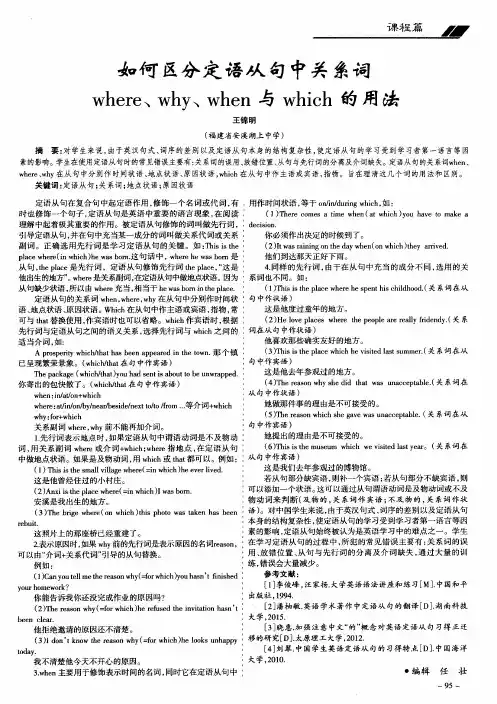
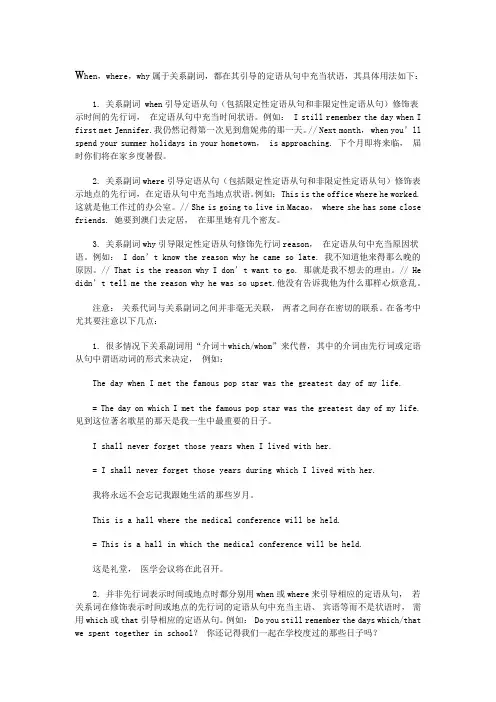
w hen,where,why属于关系副词,都在其引导的定语从句中充当状语,其具体用法如下:1. 关系副词 when引导定语从句(包括限定性定语从句和非限定性定语从句)修饰表示时间的先行词,在定语从句中充当时间状语。
例如: I still remember the day when I first met Jennifer.我仍然记得第一次见到詹妮弗的那一天。
// Next month,when you’ll spend your summer holidays in your hometown, is approaching. 下个月即将来临,届时你们将在家乡度暑假。
2. 关系副词where引导定语从句(包括限定性定语从句和非限定性定语从句)修饰表示地点的先行词,在定语从句中充当地点状语。
例如: This is the office where he worked. 这就是他工作过的办公室。
// She is going to live in Macao, where she has some close friends. 她要到澳门去定居,在那里她有几个密友。
3. 关系副词why引导限定性定语从句修饰先行词reason,在定语从句中充当原因状语。
例如:I don’t know the reason why he came so late. 我不知道他来得那么晚的原因。
// That is the reason why I don’t want to go. 那就是我不想去的理由。
// He didn’t tell me the reason why he was so upset.他没有告诉我他为什么那样心烦意乱。
注意:关系代词与关系副词之间并非毫无关联,两者之间存在密切的联系。
在备考中尤其要注意以下几点:1. 很多情况下关系副词用“介词+which/whom”来代替,其中的介词由先行词或定语从句中谓语动词的形式来决定,例如:The day when I met the famous pop star was the greatest day of my life.= The day on which I met the famous pop star was the greatest day of my life.见到这位著名歌星的那天是我一生中最重要的日子。
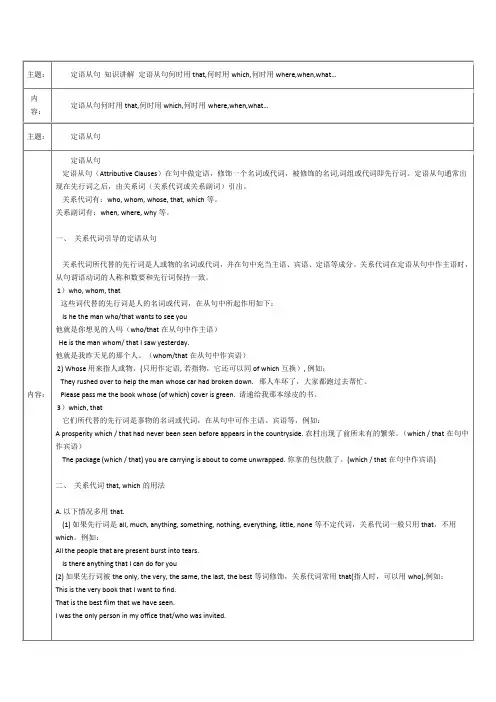
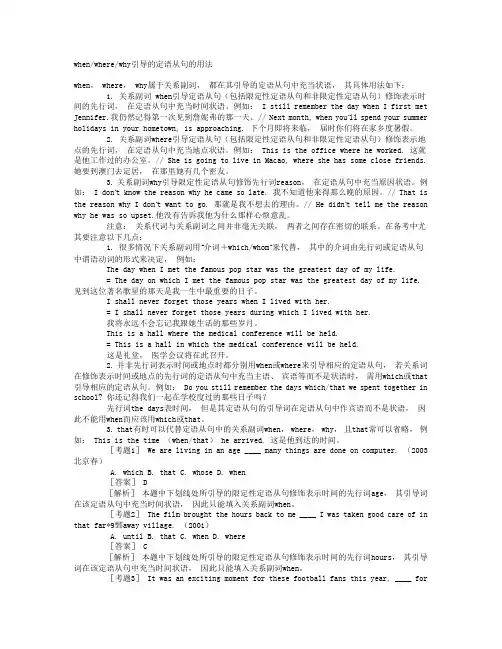
when/where/why引导的定语从句的用法when, where, why属于关系副词,都在其引导的定语从句中充当状语,其具体用法如下:1. 关系副词 when引导定语从句(包括限定性定语从句和非限定性定语从句)修饰表示时间的先行词,在定语从句中充当时间状语。
例如: I still remember the day when I first met Jennifer.我仍然记得第一次见到詹妮弗的那一天。
// Next month, when you’ll spend your summer holidays in your hometown, is approaching. 下个月即将来临,届时你们将在家乡度暑假。
2. 关系副词where引导定语从句(包括限定性定语从句和非限定性定语从句)修饰表示地点的先行词,在定语从句中充当地点状语。
例如: This is the office where he worked. 这就是他工作过的办公室。
// She is going to live in Macao, where she has some close friends. 她要到澳门去定居,在那里她有几个密友。
3. 关系副词why引导限定性定语从句修饰先行词reason,在定语从句中充当原因状语。
例如: I don’t know the reason why he came so late. 我不知道他来得那么晚的原因。
// That is the reason why I don’t want to go. 那就是我不想去的理由。
// He didn’t tell me the reason why he was so upset.他没有告诉我他为什么那样心烦意乱。
注意:关系代词与关系副词之间并非毫无关联,两者之间存在密切的联系。
在备考中尤其要注意以下几点:1. 很多情况下关系副词用“介词+which/whom”来代替,其中的介词由先行词或定语从句中谓语动词的形式来决定,例如:The day when I met the famous pop star was the greatest day of my life.= The day on which I met the famous pop star was the greatest day of my life.见到这位著名歌星的那天是我一生中最重要的日子。
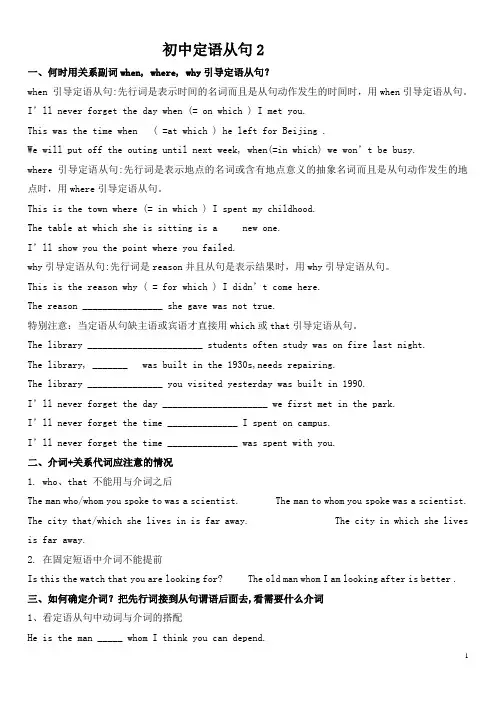
初中定语从句2一、何时用关系副词when, where, why引导定语从句?when 引导定语从句:先行词是表示时间的名词而且是从句动作发生的时间时,用when引导定语从句。
I’ll never forget the day when (= on which ) I met you.This was the time when ( =at which ) he left for Beijing .We will put off the outing until next week, when(=in which) we won’t be busy.where 引导定语从句:先行词是表示地点的名词或含有地点意义的抽象名词而且是从句动作发生的地点时,用where引导定语从句。
This is the town where (= in which ) I spent my childhood.The table at which she is sitting is a new one.I’ll show you the point where you failed.why引导定语从句:先行词是reason并且从句是表示结果时,用why引导定语从句。
This is the reason why ( = for which ) I didn’t come here.The reason ________________ she gave was not true.特别注意:当定语从句缺主语或宾语才直接用which或that引导定语从句。
The library _______________________ students often study was on fire last night.The library, _______ was built in the 1930s,needs repairing.The library _______________ you visited yesterday was built in 1990.I’ll never forget the day _____________________ we first met in the park.I’ll never forget the time ______________ I spe nt on campus.I’ll never forget the time ______________ was spent with you.二、介词+关系代词应注意的情况1. who、that 不能用与介词之后The man who/whom you spoke to was a scientist. The man to whom you spoke was a scientist. The city that/which she lives in is far away. The city in which she lives is far away.2. 在固定短语中介词不能提前Is this the watch that you are looking for? The old man whom I am looking after is better .三、如何确定介词?把先行词接到从句谓语后面去,看需要什么介词1、看定语从句中动词与介词的搭配He is the man _____ whom I think you can depend.The house ____ which he paid 100,000 yuan is very beautiful.2、看定语从句中形容词与介词的搭配He referred me to some reference books ______ which I am not very familiar.This is the hero _____ whom we are proud.3、根据先行词判断,所用的介词与先行词搭配The school ______ which I study is the No. 11 high school.The rate/speed ______ which wild animals are being destroyed has increased.The age______ which children can go to school is seven.4.根据从句中动词与先行词搭配来选用介词,这时是两者兼顾。
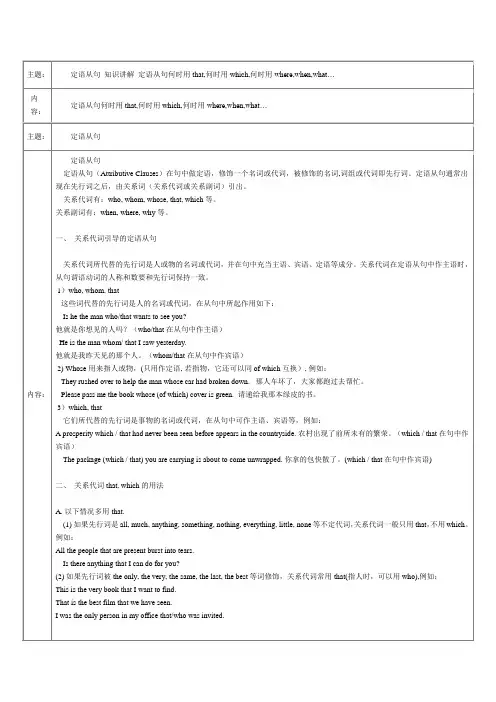
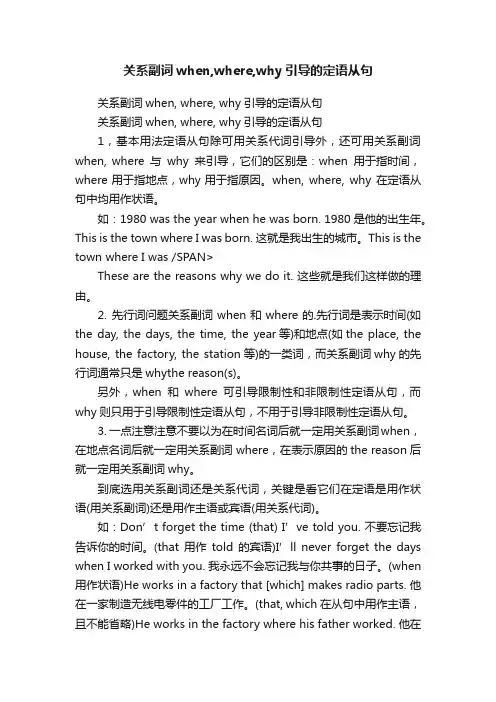
关系副词when,where,why引导的定语从句关系副词when, where, why引导的定语从句关系副词when, where, why引导的定语从句1,基本用法定语从句除可用关系代词引导外,还可用关系副词when, where与why来引导,它们的区别是:when用于指时间,where用于指地点,why用于指原因。
when, where, why 在定语从句中均用作状语。
如:1980 was the year when he was born. 1980是他的出生年。
This is the town where I was born. 这就是我出生的城市。
This is the town where I was /SPAN>These are the reasons why we do it. 这些就是我们这样做的理由。
2. 先行词问题关系副词when和where的.先行词是表示时间(如the day, the days, the time, the year等)和地点(如the place, the house, the factory, the station等)的一类词,而关系副词why的先行词通常只是whythe reason(s)。
另外,when和where可引导限制性和非限制性定语从句,而why则只用于引导限制性定语从句,不用于引导非限制性定语从句。
3. 一点注意注意不要以为在时间名词后就一定用关系副词when,在地点名词后就一定用关系副词 where,在表示原因的the reason后就一定用关系副词why。
到底选用关系副词还是关系代词,关键是看它们在定语是用作状语(用关系副词)还是用作主语或宾语(用关系代词)。
如:Don’t forget the time (that) I’ve told you. 不要忘记我告诉你的时间。
(that用作told的宾语)I’ll never forget the days when I worked with you. 我永远不会忘记我与你共事的日子。
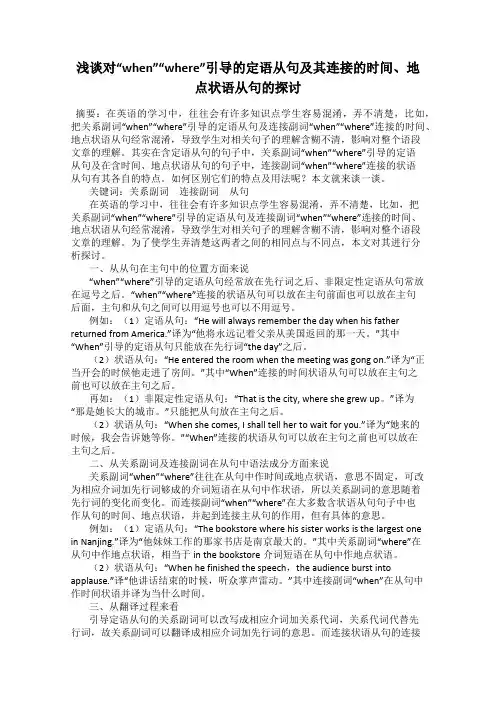
浅谈对“when”“where”引导的定语从句及其连接的时间、地点状语从句的探讨摘要:在英语的学习中,往往会有许多知识点学生容易混淆,弄不清楚,比如,把关系副词“when”“where”引导的定语从句及连接副词“when”“where”连接的时间、地点状语从句经常混淆,导致学生对相关句子的理解含糊不清,影响对整个语段文章的理解。
其实在含定语从句的句子中,关系副词“when”“where”引导的定语从句及在含时间、地点状语从句的句子中,连接副词“when”“where”连接的状语从句有其各自的特点。
如何区别它们的特点及用法呢?本文就来谈一谈。
关键词:关系副词连接副词从句在英语的学习中,往往会有许多知识点学生容易混淆,弄不清楚,比如,把关系副词“when”“where”引导的定语从句及连接副词“when”“where”连接的时间、地点状语从句经常混淆,导致学生对相关句子的理解含糊不清,影响对整个语段文章的理解。
为了使学生弄清楚这两者之间的相同点与不同点,本文对其进行分析探讨。
一、从从句在主句中的位置方面来说“when”“where”引导的定语从句经常放在先行词之后、非限定性定语从句常放在逗号之后。
“when”“where”连接的状语从句可以放在主句前面也可以放在主句后面,主句和从句之间可以用逗号也可以不用逗号。
例如:(1)定语从句:“He will always remember the day when his father returned from America.”译为“他将永远记着父亲从美国返回的那一天。
”其中“When”引导的定语从句只能放在先行词“the day”之后。
(2)状语从句:“He entered the room when the meeting was gong on.”译为“正当开会的时候他走进了房间。
”其中“When”连接的时间状语从句可以放在主句之前也可以放在主句之后。
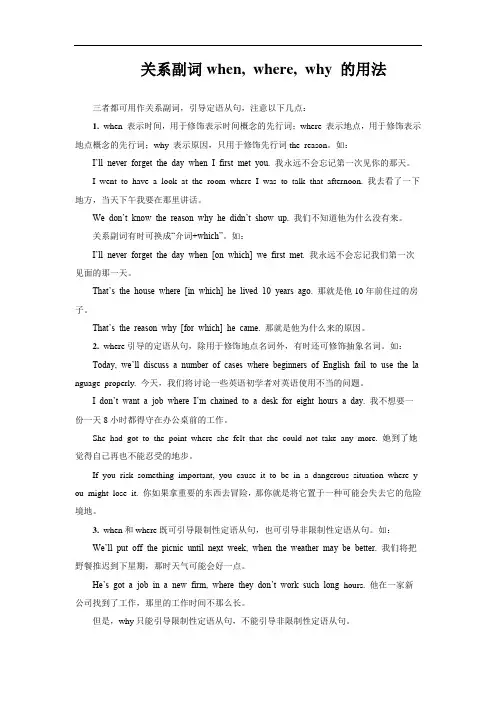
关系副词when, where, why 的用法三者都可用作关系副词,引导定语从句,注意以下几点:1.when 表示时间,用于修饰表示时间概念的先行词;where 表示地点,用于修饰表示地点概念的先行词;why 表示原因,只用于修饰先行词the reason。
如:I’ll never forget the day when I first met you. 我永远不会忘记第一次见你的那天。
I went to have a look at the room where I was to talk that afternoon. 我去看了一下地方,当天下午我要在那里讲话。
We don’t know the reason why he didn’t show up. 我们不知道他为什么没有来。
关系副词有时可换成“介词+which”。
如:I’ll never forget the day when [on which] we first met. 我永远不会忘记我们第一次见面的那一天。
That’s the house where [in which] he lived 10 years ago. 那就是他10年前住过的房子。
That’s the reason why [for which] he came. 那就是他为什么来的原因。
2.where引导的定语从句,除用于修饰地点名词外,有时还可修饰抽象名词。
如:Today, we’ll discuss a number of cases where beginners of English fail to use the la nguage properly. 今天,我们将讨论一些英语初学者对英语使用不当的问题。
I don’t want a job where I’m chained to a desk for eight hours a day. 我不想要一份一天8小时都得守在办公桌前的工作。
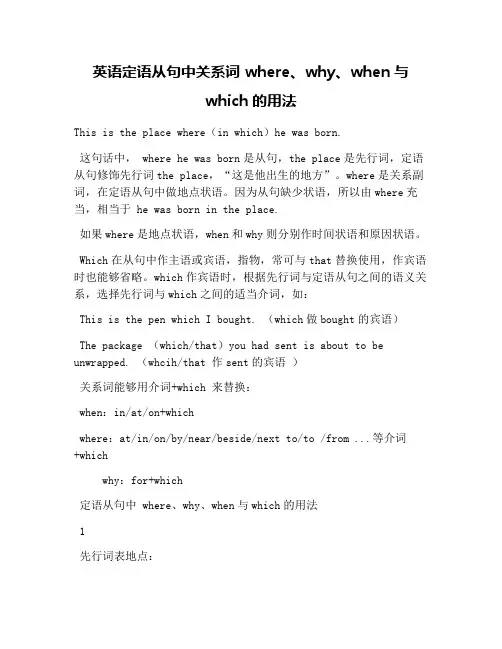
英语定语从句中关系词 where、why、when与which的用法This is the place where(in which)he was born.这句话中, where he was born是从句,the place是先行词,定语从句修饰先行词the place,“这是他出生的地方”。
where是关系副词,在定语从句中做地点状语。
因为从句缺少状语,所以由where充当,相当于 he was born in the place.如果where是地点状语,when和why则分别作时间状语和原因状语。
Which在从句中作主语或宾语,指物,常可与that替换使用,作宾语时也能够省略。
which作宾语时,根据先行词与定语从句之间的语义关系,选择先行词与which之间的适当介词,如:This is the pen which I bought. (which做bought的宾语)The package (which/that)you had sent is about to be unwrapped. (whcih/that 作sent的宾语)关系词能够用介词+which 来替换:when:in/at/on+whichwhere:at/in/on/by/near/beside/next to/to /from ...等介词+whichwhy:for+which定语从句中 where、why、when与which的用法1先行词表地点:先行词表示地点时,如果定语从句中谓语动词是不及物动词,用关系副词where或介词+which;where指地点,在定语从句中做地点状语。
如果是及物动词,用which或that都能够。
例如:(1)This is the small village where(=in which)he ever lived.这是他以前住过的小村庄。
(2)Beijing is the place where(=in which)I was born.北京是我出生的地方。
where与when在定语从句的用法where与when在定语从句的用法where与when在定语从句是如何使用的?们知道哪些用法呢?在定语从句中where when 的用法:(1)when 可以代替in/on which 引导时间定语从句.例如 That was the year when he was born.那是他出生的那一年.Sunday is a day when people don't have to go to work.星期天是人们不用上班的一天.(2)where可以代替in/on which 引导地点定语从句.例如:Let's meet at the gate where you can see the panda.我们在能看到大熊猫的那个大门见面吧.She is teaching at the university where her mother once studied.她在她母亲曾经过的大学执教.This is the birdge where you took photos.这是你照相的那座桥.关系副词Where在定语从句中的用法先行词表示地点,不一定都用Where引导定语从句一般来说,学习者的脑海中会形成这样一个概念:在定语从句中,如果先行词是表示地点的名词(如place等),就用关系副词where引导定语从句。
这种理解有一定的道理,比如下面这个句子:1. If there is anyone out there who still doubts that America is a place where all things are possible, who still wonders if the dream of our founders is alive in our time, who still questions the power of our democracy, tonight is your answer.如果还有人对美国是否是一个一切皆有可能的国家心存怀疑,还有人怀疑美国奠基者的梦想在我们所处的时代是否依然鲜活,还有人质疑我们的民主制度的力量,那么今晚,这些问题都有了答案。
1、关系副词where的用法(1)where的先行词大多是地点名词,在定语从句中作地点状语从句。
This is the school where/in which my father once worked.这是我父亲曾经工作过的学校(2) where的先行词还可以是抽象名词, 如stage,case, situation,position等。
例 They have reached the stage where/at which they will separate 他们已经到了将要分手的地步了。
2、关系副词when的用法(1)when的先行词是时间名词,在定语从句中作时间状语。
例 Do you remember the day when/on which we first met each other ?你还记得我们第一次见面的那一天吗?(2)when的先行词还可以是抽象名词, 如break, interval等。
例There is a long break between the two classes when/at which we can drink some water .在两节课之间有一个长的休息时词,在这期间我们可以喝点水。
3、关系副词why的用法why的先行词是reason,在定语从句中作原因状语。
reason作先行词时,若引导词在从句中作主语或宾语,定语从句要用that或 which引导。
例 I don ' t know the reason why/for which my good friend , jack ,looks unhappy today.我不知道我的好朋友杰克为什么今天看上去不高兴。
(1) The reason why…..是why引导的定语从句,Why在从句中作原因状语,Why可替换成 for which。
(2) The reason that……是that引导的同位语从句,that不作成分,that后面的内容说明 reason的内容。
定语从句where,when,why用法归纳
Sep 12, 2015
一.定语从句: where/ when / why = 介词+which。
二.判断定语从句的方法: 放在名词后的从句,多为定语从句。
三.判断引导词的方法:将从句前的名词,也就是先行词,用到从句中去,如果是“介词+先行词”出现在从句中,就考虑“介词+which”= where / when / why 做引导词。
例如:
1.This is the place in which / where I am working.
这是我工作的地方。
(说明:the place 是先行词,将其用到从句中,出现in the place; in
the place= in which = where.)
2.I’ll never forget the days during which / when we studied together.
我将永远忘不掉我们一起学习的日子。
(说明:the days是先行词,将其用到从句中,出现during the days;
during the days = during which =when.)
3.We don’t know the reason for which / why he didn’t come to school
today.
我不知道他今天为什么没有来上学。
(说明:the reason 是先行词,将其用到从句中,出现for the reason;
for the reason = for which = why.)。
when、where和why关系副词的用法在英语中,引导定语从句的关系副词主要有when,where, why,它们在从句中分别可以作时间状语、地点状语和原因状语。
When的用法先行词指时间When可以引导限制性和非限制性定语从句,其先行词需是表示时间的名词,如day, year, time等。
如:I’ll never forget the day when I met you.注:这里的先行词是表示时间的名词day,所以要用when 引导定语从句。
这里when作从句的时间状语,修饰谓语动词met.My favorite season is spring, when the earth seems born again.注:这里是when引导的非限定语从句,先行词是表示时间的名词spring。
We will put off the outing until next week, when we won’t be so busy.注:这里的when引导的是非限制性定语从句,先行词是表示时间的短语next week.关系副词when在从句中作时间状语总之反复强调when是在定语从句中作时间状语。
换句话说,若定语从句不是缺少状语,而是缺少主语或宾语,那么即使先行词是表示时间的名词,也不能用when而要用which 或that来引导定语从句。
因为when来引导定语从句的前提条件是:when必须在其引导的定语从句中作时间状语。
如:1. I’ll never forget the time which I spent on campus.2. I’ll never forget the day when we first met in the park.注:两句话中,尽管先行词分别是表示时间的名词time 和day,但用的关系词不同。
第一句中,由于定语从句的谓语spent缺宾语,因此关系词要充当这一宾语,故要用which。
定语从句II(where, when, why )1. when 指时间,在从句中作时间状语,它的先行词为time, day, date, morning, night, week, year, moment, period, age等,亦可用“介词+which”替代。
The time when I first met Nelson Mandela was a very difficult period of my life. We went through a period when everything was expensive in the market.I still remember the time when I first traveled by plane.2. where指地点,在从句中作地点状语。
它的先行词通常为place, spot, street, house, room, city, town, country等,亦可用“介词+ which”替代。
Can you tell me the company where he worksChina is the only country where wild pandas can be found.This is the house where I lived two years ago.3. why 指原因或理由,它的先行词只有reason,在定语从句中作原因状语,亦可用“介词for+ which”替代。
Can you tell me the reason why you didn’t come to his birthday party Please give me the reason why you were late this time.4. Give a little display of your great talent:I will never forget the days when I worked in the countryside.I will never forget the days that/which I spent in the countryside.He remembered the day when I arrived in this big city.I went back to the place where I was born and grew up.This is the factory where my father worked last year.This is the factory that/which my father visited last year.The school where I study French is very large.We don't know the reason why they didn't attend the meeting.The reason that/which he gave us was hard to accept.The reason why he was late for school is that he missed the first bus. That is the reason why she doesn’t come to work as usual.。
一、考查关系词的指代及其在从句中所作的语法成分
定语从句要由关系词来引导,关系词分为关系代词和
关系副词。
关系代词有:who, whose, whom, that, which 等;关系副词有:when,where,why等。
除that只引导限定性定语从句外,其余的关系词既可以引导限定性定语从句,也可以引导非限定性定语从句。
要点提示:要正确使用关系词,就须将两个方面结合起来考虑:一方面是看看关系词所指代的先行词的类属;另一方面是准确分析关系词在定语从句中所作的句子成分。
若指人,作主语用who,作宾语用whom(可以省略),作定语用whose(还可指物);若指物且作主语或宾语,则用which(在非限定性定语从句中,也可指代一个情形,即主句全部内容。
无论作主语还是作宾语,均不可省略)或that(还能指人,作宾语时,可以省略);作状语指时间用when,指地点用where,指原因用why等。
考题:
1.His parents wouldn't let him marry anyone
_______ family was poor. (MET'88)
A.of whom
B.whom
C.of whose
D.whose
2.Dorothy was always speaking highly of her role in the play, _______ of course, made the others unhappy. (NMET2000)
A.who
B.which
C.this
D.what
3.After living in Paris for fifty years he returned to the small town _______ he grew up as a child. (NMET'96)
A.which
B.where
C.that
D.when
4.Carol said the work would be done by October, _______ personally I doubt very much.(NMET'99)
A.it
B.that
C.when
D.which
5.I also enjoyed the evenings when we spent together. (NMET'95短文改错)
答案及简析:
1.答案为D。
此处关系词指代的是anyone,而且作从句中的定语。
2.答案为B。
该题旨在考查非限定性定语从句的引导词,只能在A,B之间选择,可是这里并未指人,而是指主句所谈情况,为此,只能选B。
3.答案为B。
关系词指代地点the small town,同时在定语从句中充当状语。
4.答案为D。
不可认为指代时间by October而误选C。
其实,稍加分析就可清楚关系词指代的是主句全部内容且
作doubt的宾语而非状语。
5.此题先行词是表时间的名词evenings,但在从句中用作spent的宾语而不是状语,故须将when改为
that/which或去掉when。
二、考查关系词的搭配方式
关系词的搭配方式主要是指as及作提前介词宾语的which和whom的搭配方式。
(一)as的搭配方式
要点提示:1. 在限定性定语从句中,常见的搭配方式有:the same...as,as...as,not so / as...as, such...as 等。
2.在非限定性定语从句中,常见的搭配方式有:as we all know(=as is known to us all),as is
said(reported,mentioned,etc.)above,as it is等,可置于句首、句中或句末。
考题:
_______ is known to everybody,the moon travels round the earth once every month.(NMET2001)
A. It
B. As
C. That
D. What
答案与简析:答案为B.显而易见,为一固定搭配方
式.As引导的是非限定性定语从句。
(二)which和whom的搭配方式
要点提示:1.多用于限定性定语从句中,作提前介词的宾语,即介词+which/whom.介词的使用要依据定语从句中
动词短语的构成方式而定。
2.在作从句主语时,往往套用:名词(代词、数词
等)+of+which/whom.多见于非限定性定语从句中。
考题:
1.In the dark street,there wasn't a single person _______ she could turn for help. (NMET'92)
A.to whom
B.who
C.from whom
D.that
2.He paid the boy $10 for washing ten windows,most of _______ hadn't been cleaned for at least a year. (MET'90)
A.these
B.those
C.that
D.which
3.Recently I bought an ancient Chinese vase, ______ was very reasonable. (2000上海)
A.which price
B.the price of which
C.its price
D.the price of whose
答案与简析:
1.答案为A。
turn to sb. for help 是一固定搭配方式。
2.答案为D。
which指代ten windows且作of的宾语,that不能用在非限定性定语从句中,也不能与介词一起提前作宾语。
3.答案为B。
which指代the ancient Chinese vase,与the price构成所属关系。
三、考查使用that的情况及关系词的省略现象
(一)只能使用that的情况
要点提示:
1.由不定代词anything,nothing,everything,all, one, little,few,much等充当先行词时;
2. 当先行词前有序数词或形容词最高级修饰时;
3.当先行词被no,the same,the very, the only等修饰时;
4. 当先行词既指人又指物时;
5. 主句是以who开头的疑问句时.
考题:
All _______ is needed is a supply of oil. (MET'89)
A.the thing
B.that
C.what
D.which
答案与简析:答案为B,因为先行词是由不定代词all
充当的。
(二)关系词的省略现象
要点提示:除作宾语的关系代词whom,which,that可以省略外,先行词为way,time等时,可将that省略,其中way 还可以由in which来引导。
考题:
I don't like______you speak to her.(1993上海)
A.the way
B.the way in that
C.the way which
D.the way of which
答案与简析:答案为A.根据句意:我并不喜欢你对她讲话的方式,理应选the way,其后省去了关系代词that。
(文/李英旭;《英语通》高二版 03~04学年度第4期;版权归英语辅导报社所有,独家网络合作伙伴新浪教育,未经许可,不得以任何形式进行转载。
)
阿山来自爱问知识人 2005-10-25 19:32
评论
提问者对答案的评价:。